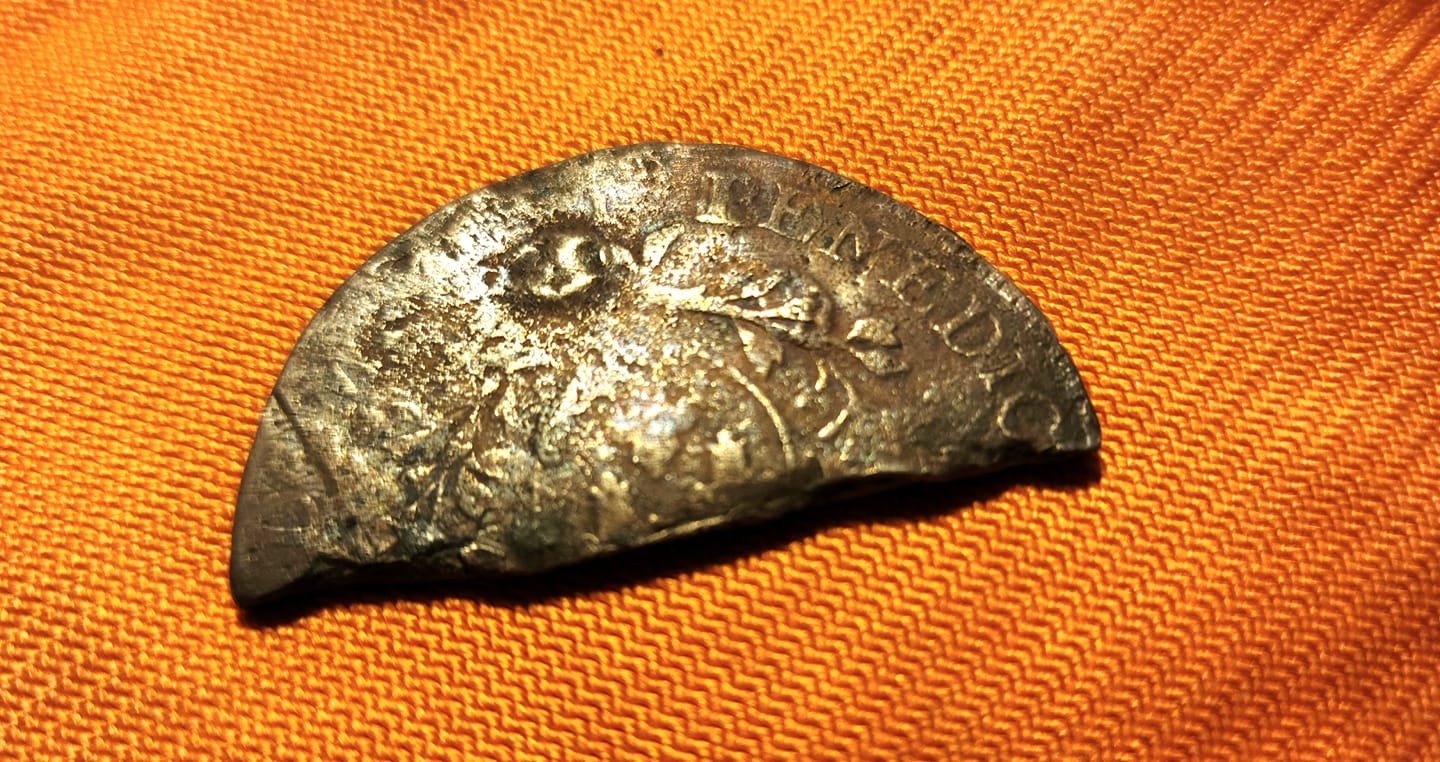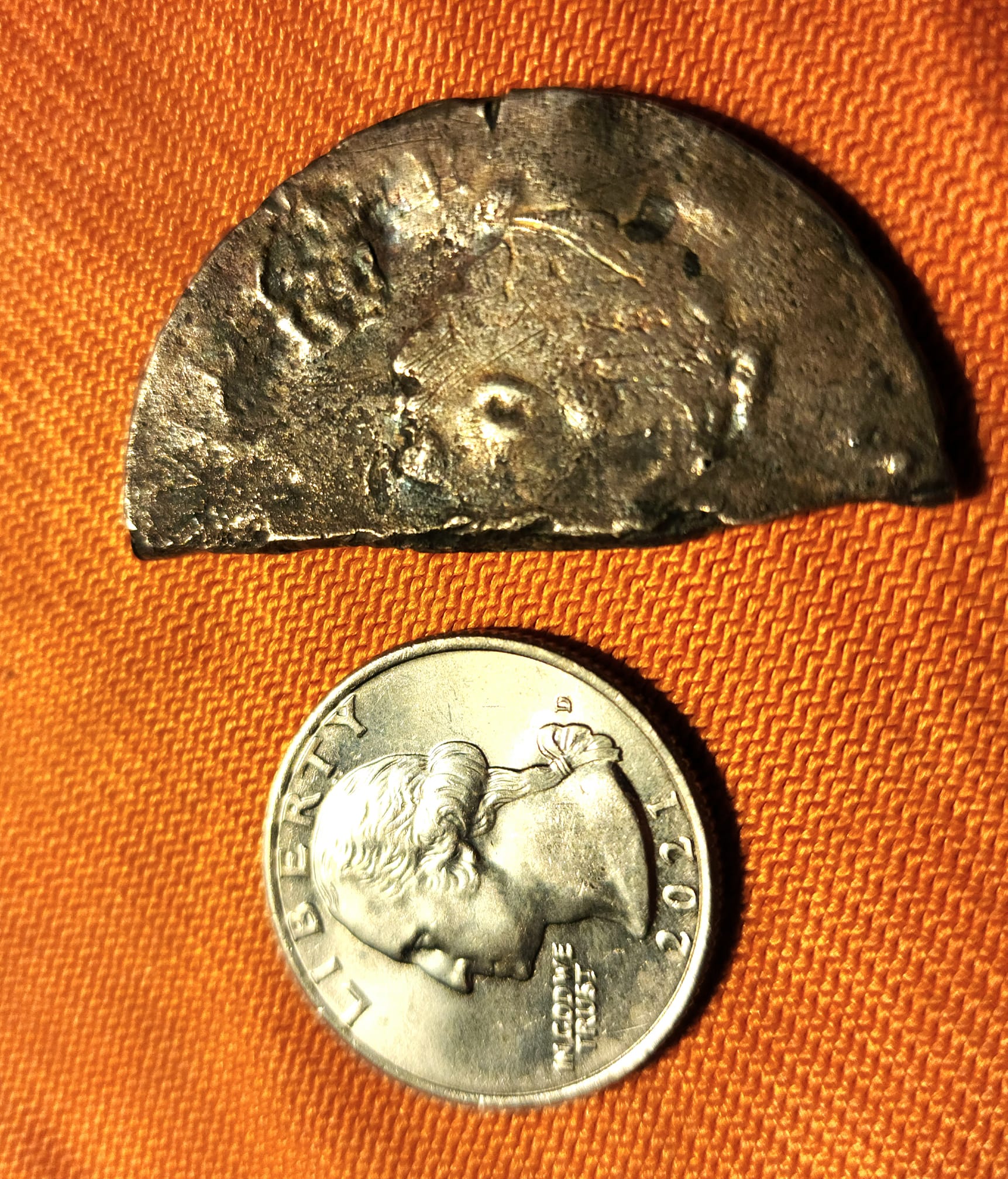Collecting Friends: Counterfeits Overboard
Dennis: Recently I was sorting through a hoard of coins I bought about twenty years ago and I found some counterfeit Liberty Seated pieces.
One of the fakes was an 1858-S half dollar. If it were one of the 476,000 authentic halves minted in San Francisco that year, it would have been worth about $500 to $600. Ron Guth in “CoinFacts” describes the 1858-S as having “a reasonably large mintage for the period.” Q. David Bowers in the Guide Book of Liberty Seated Silver Coins observes, “These are scarce [in circulated grades] and are usually seen well worn.” In Mint State they’re rare.
Even though the fake wouldn’t fool an experienced dealer or collector, I didn’t feel comfortable letting it live in the civilized world, where someone might mistake it for real. I decided to consign it to a freshwater grave—I flipped it into a nearby lake. I videoed the experience for my “Medals and Coins Scattered Here and There to Be Randomly Found” Facebook page. (Or in this case, to never be found.)
Caption: Sending a fake Liberty Seated half dollar to a watery grave.
Friends in the hobby community had mixed feelings.
Some had fun with it. “But wait,” protested Wyoming-based coin dealer Bill Lorman. “It looks genuine! Oops.” Retired Whitman Publishing art director Bob Cashatt asked, “Are you sure you grabbed the right coin?” (I assured them it’s a real 1858-S, but the “S” stands for Shanghai.) Dealer Matt Dinger, co-host of the “Coin Show Podcast,” imagined the fake being found by a magnet fisherman. “I feel sorry for the coin shop they take it to,” he said. “Nobody is gonna believe that someone just tosses counterfeit coins in a creek.” George Cuhaj, curator at the Higgins Museum of National Bank Notes, jokingly warned, “There are some scuba students doing a field trip today.” Jim Robinson and Michael Heim thought it looked like an episode of “Oak Island”—“But it would take three seasons to find it,” Heim said, “and then we would have to wait til the fourth season to see!”
American Numismatic Society vice president and honorary curator David Hendin envisioned the fake being discovered in 25 years at the bottom of the lake and being declared “genuine, with impeccable provenance.” (I countered that it’s more likely to dissolve in six months!)
Goldsmith David Emslie opined, “My melting and shredding and putting-through-rolling-mill videos are better!” (He physically destroys counterfeits with machinery.)
“I would have kept that,” said detectorist Kelley Rea, who recalled finding a counterfeit cut 8-reales about ten years ago in a Civil War soldier’s property dating to the 1700s. “The coin was copper with silver overlay,” she said. “The counterfeit was worth more than the real thing.”


Caption: Kelley Rea has found counterfeit coins while treasure-hunting. (Photos courtesy of Kelley Rea)
My 1858-S counterfeit wasn’t contemporary to its authentic source, though. It wasn’t made in the 1850s or even in the 1950s, but probably in the early 2000s. It was a pot-metal impostor, made not to pass in circulation but to trick collectors.
Some numismatists felt I should have kept the fake for further study. One recommended I give it to Jack Young, a mechanical engineer by training, well known as a researcher and educator in the field of counterfeit coinage.
Others agreed with sending it to oblivion. Hobbyist Tom Pearce said, “Thank you. That’s what I do with mine when I find them. I’m the end of the line.”
Dave Bowers notes that 21 authentic 1858-S Liberty Seated half dollars were inventoried in the wreck of the SS Republic, which sank in 1865 and was discovered in 2003 off the coast of Georgia. Now they’re joined in spirit by a fraudulent cousin at the bottom of one of Georgia’s inland lakes, where only turtles and fish can admire it.
Steve, what are your thoughts on counterfeit coins, and what do you do with them when you find them?
Steve: First, the idea of a turtle at the bottom of one of Georgia’s inland lakes admiring a counterfeit coin delights me. Definitionally, a counterfeit object needs to have an intent to deceive or defraud, but since objects can’t speak for themselves, one has to consider the intent of its maker before labeling something a pure counterfeit.
I’ve found plastic “play money” in the rejected coin return at the supermarket’s coin counting machine, and I just put that in an ever-growing bag of numismatic “stuff” that I’ll one day figure out what to do with. Those aren’t counterfeits, in that they weren’t intended to trick people; rather, they were just supposed to serve as an educational coin-shaped substitute that was presumably less harmful for a child to eat than an actual coin.
As a young collector in the 1990s I was fascinated reading about the “Omega” counterfeits in Coin World and Numismatic News. These emerged at the ANA’s 1971 convention and the proud – still unknown – maker inserted an Omega symbol within the eagle’s talons on the reverse of the die that struck gold counterfeit 1907 High Relief Saint-Gaudens $20 gold double eagles. The “signed” reverse reminded me of the pride that some ancient Greek coin designers took when they would sign their dies, which continues today with the little letters placed within a coin’s design that identifies the designer and engraver.
Coin counterfeiting technology has improved significantly in the past decades since the “Omega” counterfeits emerged, but these are still incredibly impressive coins. They are distinguished from the 1858-S Seated Liberty half dollar you discussed in that they were made to trick even the most practiced numismatists. The Hobby Protection Act, passed in 1973, prohibits the manufacturing, importing, or selling imitation numismatic items, unless they are marked in accordance with regulations prescribed by the Federal Trade Commission, so I’m glad you didn’t sell your counterfeit half dollar, Dennis! You are a responsible numismatist!
Be on the lookout for another installment of Collecting Friends next month or subscribe here and never miss a post! In the meantime, explore beautiful coins from the ANA's Edward C. Rochette Money Museum Virtual Exhibits.
About the Collecting Friends Blog
Hello! And welcome to the ANA’s blog series, “Collecting Friends.”
We decided to approach this much like a conversation between friends. One of us starts with a topic, then the other responds. Simple as that. Along those lines, we’ll keep the tone conversational as much as possible.
We both write about coins professionally, and will keep our relative style guides in our writing. For Dennis, Publisher at Whitman Publishing, that means capitalizing “Proof” and italicizing Red Book and never saying anything bad about Ken Bressett, who’s awesome anyway.
For Steve, who’s written with Coin World for 15 years, it means Winged Liberty Head dime instead of “Mercury” dime, and similar nuances and oddities. And, it means writing A Guide Book of United States Coins (better known as the “Red Book”).
Both of us started collecting when we were little, introduced to coins by a chance encounter with an old coin that sparked our curiosity. One of Steve’s interests is coin valuation, and he gravitates towards the intersection of art and coins. Dennis enjoys medals and world coins, and studying modern U.S. coins in the context of older series, what came before.
We met in 2012 at the American Numismatic Association World’s Fair of Money in Philadelphia at an event hosted by the Austrian Mint where there was both a Ben Franklin and a Betsy Ross impersonator. We’ve become great friends in the past decade. We even were appointed together to sit on the Citizens Coinage Advisory Committee starting in 2016, but Steve resigned soon after he was appointed to accept a full-time job at the Treasury Department while Dennis was re-appointed in 2020.
We taught a course together on numismatic publishing and writing a few years ago at the Summer Seminar, and while life has gotten in the way of us teaching another class, we jumped at our friend Caleb’s suggestion that we write a column. We hope you enjoy it!
.png?width=300&height=300&name=steve%20roach%20circle%20frame%20(2).png)
.png?width=300&height=300&name=dennis%20tucker%20circle%20frame%20(2).png)
About the American Numismatic Association
The American Numismatic Association is a nonprofit organization dedicated to educating and encouraging people to study and collect coins and related items. The Association serves collectors, the general public, and academic communities with an interest in numismatics.
The ANA helps all people discover and explore the world of money through its vast array of educational programs including its museum, library, publications, conventions and numismatic seminars.

.jpg)